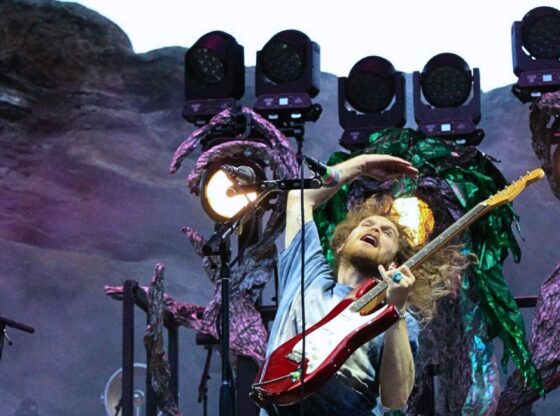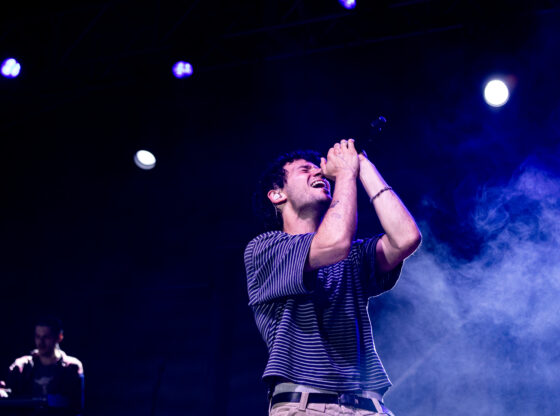NEW YORK–It’s tempting to attribute some greater symbolism to the rather familiar clothes that are being previewed for next spring during Fashion Week here.
One might assume that designers are sending a message with their intentional pairing of cargo pants, bomber jackets and Army green fabrics with frail and pale lace and sensuous silk. War meets the boudoir? Combat gear shelters our innocence? Barbie meets G.I. Joe, borrows his wardrobe and they live happily ever after?
Maybe all of the above are true, but this is, after all, New Yawk, where fashion is about moving the merchandise, not artsy expressions of angst. The telling sign of the bottom-line pressures surfaced backstage at Tommy Hilfiger’s show Wednesday. The designer who made his fame and fortune with unabashedly patriotic red, white and blue Americana clothing practically buried his stars-and-stripes heritage in his newest collection.
“I’m not abandoning it,” he said backstage, “but I’m incorporating it in a more subtle way.” Translation: Red-white-and-blue has new connotations these days, and it’s overused and overexposed as a fashion statement. Hilfiger resisted attaching metaphorical meanings to his multipocketed military wear, too. “It has nothing to do with the state of the union,” he insisted. “We live in an era when women love military pockets for everything they carry.”
Translation: It looked great when John Galliano did this fall’s combat couture look for Christian Dior–and we all need to sell fashion. To Hilfiger’s credit, he gave what used to be a predictable collection a new dose of sex appeal that put his women’s clothes more in step with those of other major Seventh Avenue designers.
You know that fashion is paying closer attention to consumer needs, street trends and, perhaps, the trend analysts when Hilfiger, champion of the baggy hip-hop blue jean, starts to share the same silk cargo-pants aesthetic with Carolina Herrera, the queen of elegance. Herrera and even DKNY by Donna Karan and Kenneth Cole shared their utility/safari/military territory with sexy civilians in miniskirts and romantics in white.
While Karan skillfully returned to her love of 1940s dressmaking and sharp tailoring, Herrera less gracefully updated the silhouettes of that era. Karan playfully accented her pink, polka-dotted and peony-printed collection with makeup straight from a 1961 Barbie doll, complete with painted-on lashes, a slash of blue eye shadow and an up ‘do nearly undone from numerous tours of duty in the toy box. (They also looked like front-row regular Ivana Trump, who has shed her famous Barbie up ‘do for long hair extensions that make her look like a cross between Donatella Versace and Dolly Parton.)
If life-size Barbies can walk a runway, then fashion hasn’t lost its sense of humor. While many expected some sort of somber tribute to the recently departed Bill Blass at his show Thursday morning, there was none (fitting for the man who requested no funeral). Instead, Blass’ capable successor, Lars Nilsson, turned out a happy collection in uplifting pinks and reds. Whether he presented a classic shirtdress or a voluminous ball gown, Nilsson lavished each with frilly bands of lace or delicate rows of pin-tucked ruffles. We all would have been a lot happier, however, if he’d left the suits with Bermuda shorts in the back room. No one has ever looked chic in them and they never will.
Like Nilsson, Oscar de la Renta designs for a wealthy, discriminating clientele who consider grunge an insult to humanity. While De la Renta’s show featured his signature lace skirts, ruffled and ruched evening dresses and lush fabrics, the collection, like many here, rarely strayed from his lovely, but safe, territory.
Innovation has been slow to appear this week, in part because many of the top designers are seasoned pros who have mastered their methods. That’s what makes 21-year-old Zac Posen so interesting as a fashion darling. Although he has shown only one other runway collection earlier this year in New York, his show Thursday gave hope that he’s not a one-hit wonder. The pressure was intense as top retailers, a crush of reporters and celebrities such as Natalie Portman, Bernadette Peters, Julianne Moore and Ellen Barkin lined the front row of his show, the first in the landmark Gotham Hall, once a grand 1922 bank.
Posen’s now trademark chevron-piecing, dramatic flourishes and retro silhouettes gave his special-occasion clothes a lively glamour, even though many carry the faint vapor of vintage shop costumes. Although his fluffy, ruffly mini-dirndls are for the young and leggy, his precisely tailored jackets and suits have appeal for a grande dame looking for a showy dinner suit. Although some ideas seemed like design school studies in contrast and construction, and others were inspired by Martin Margiela (rows of snaps that can cinch folds of a full-cut jacket), Posen’s clothes don’t look like much else in fashion. And newness is the industry’s lifeblood.
The real future of fashion may not be with the wunderkind who repeats the greatest looks of the 20th century, but with those who reinvent them. Marc Jacobs, who also designs Louis Vuitton in Paris, consistently invokes the grandmotherly looks of his ’60s childhood and the cocktail culture of the ’50s. His skill, however, is making clothes that were dowdy on Bubbe four decades ago look sexy on fresh-faced young women today. For spring, his cocktail-culture collection included the kind of tightly fitted, sweetly pretty and potent dresses that women wore to sip martinis and win rich husbands. He also poured models into skintight straight skirts and demure cardigans perfect for a typecast sexy secretary.










